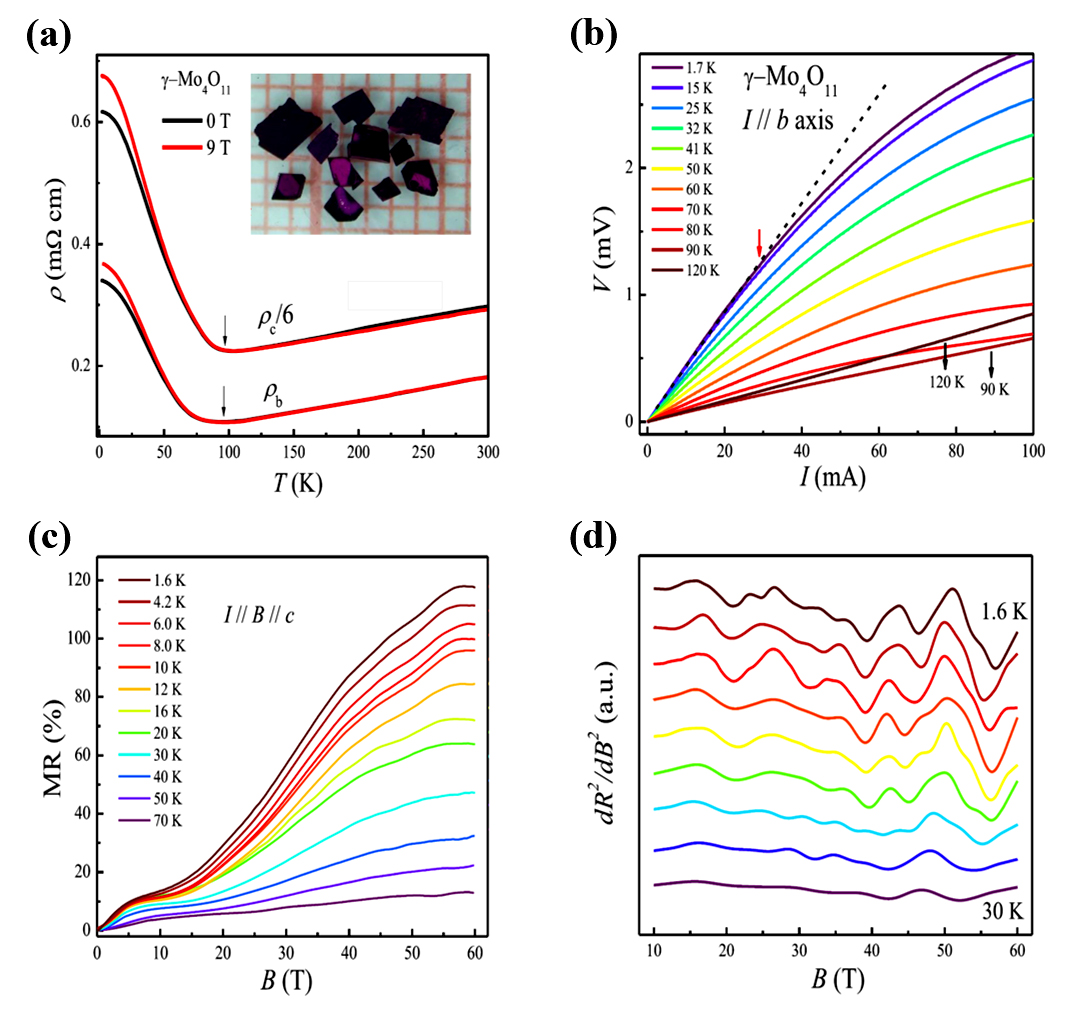
(a)Temperature dependence of ρb. (b) I-V curves of ρb. (c) Magnetic field dependence of ρc up to 60 T. (d) Second derivative curves of ρc as a function of B.
Background
One common viewpoint related to themolybdenum bronzesis that the hidden Fermi surface (FS) nesting gives rise to a charge-density-wave (CDW) formation.Because of an imperfect nesting of the hidden FS, some pockets may remainand the system thus shows many exotic transport properties in its CDW state.The two phases of the molybdenum oxide Mo4O11, monoclinic η and orthorhombic γ are typical purple bronzes thatpossess the hidden Q1D FS nesting and thus the CDW instability at low temperatures.The molybdenum bronze η-Mo4O11 has received continued interests due to a variety of magneto-transport properties in its CDW state. However, in contrast to η-Mo4O11, the magneto-transport property of γ-Mo4O11 in the low temperature CDW state has not been revealed inexperiment and thus is still open question.
What we discover?
In this work, we report a comprehensive experimental study on the Q2D CDW oxide bronzes Mo4O11, in which the CDW instability dominated by a hidden Fermi surface nesting results in magnetic field-induced novel properties. Different from the monoclinic η-phase, the orthorhombicg γ-Mo4O11 shows a flexible CDW transition with a nearly fully opened gap evidenced by a nonlinear transport behavior related to the CDW sliding motion, which was only observed in Q1D systems. Furthermore, the high-field MR up to 60 T shows quantum oscillations, which provide a well platform for us to study its FS structure atlow temperatures. In addition, the comparative study of the high-field oscillations supports that γ-Mo4O11 has a nearly fully opened CDW gap and thus requires a higher critical field to observe its highest breakdown frequency in experiment.
Why is this important?
The accommodation of Luttinger liquid behaviors and unique quasiparticles in the CDW state has led to a renewed interest of the low-dimensional molybdenum bronzes. However, the magneto-transport property of the purple bronze γ-Mo4O11 has never been reported to date.Here, we report a comprehensive study of the sample synthesis, magnetic susceptibility, specific heat and transport properties in the Q2D CDW compound γ-Mo4O11.The number of key features such as nonlinear current-voltage relation, field-induced quantum oscillations associated with the CDW properties are uncovered via a comparative study on γ-Mo4O11 and η-Mo4O11.This study reveals that γ-Mo4O11is distinct from traditional Q1D or Q2D CDW compounds and provides opportunity to study the CDW electrons and nonlinear transport properties in such a Q2D system.
Why did we need WHMFC?
The high-field technique has been actively utilized in exploring the competing electronic orders in strongly correlated systems over the past years.In this work, high-field magnetoresistivity up to 60 T was measured relying on the electrical transport platform at the Wuhan National High Magnetic Field Center (WHMFC), china. The high-field transport measurements have been developed very skillfully and achieved good results in the WHMFC.
Who did the research?
J. Z. Ke1, M. Yang1, H. P. Zhu1, C. Dong1, M. Y. Shi1,Z. Y. Wu,1X. F. Xu,2H. K. Zuo,1Y. Liu,3J. Shi,3andJ. F. Wang1
1Wuhan National High Magnetic Field Center and School of Physics, Huazhong University of Science and Technology, Wuhan 430074, China.
2Department of Applied Physics, Zhejiang University of Technology, Hangzhou 310023, China.
3School of Physics and Technology, Wuhan University, Wuhan 430072, China.
Acknowledgments
This work was supported by the National Natural Science Foundation of China (Grants No. U1832214, No. 12004122, No. 12074135 and No. 12074291), the Fundamental Research Funds for the Central Universities (Grant No. 2018KFYXKJC005).
Link:https://doi.org/10.1103/PhysRevB.104.195154
